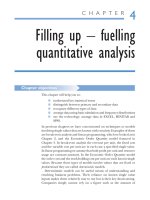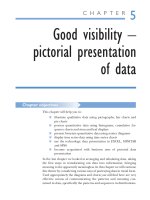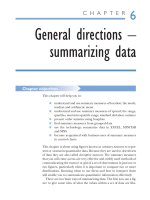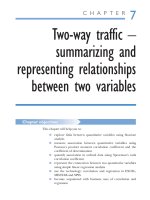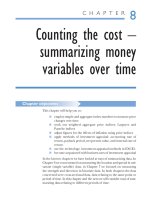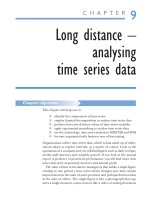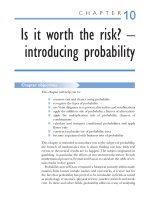Quantitative methods for business 5th waters
Bạn đang xem bản rút gọn của tài liệu. Xem và tải ngay bản đầy đủ của tài liệu tại đây (8.65 MB, 625 trang )
Quantitative Methods for Business
Fifth
Edition
Managers in every organisation use quantitative methods. One of their essential skills is the ability
to understand numerical information and use it for decision making. Not surprisingly, management
students do a course in quantitative methods, typically with names like quantitative analysis, decision
analysis, business modelling or financial methods. This book gives an introduction to methods that
are widely used in business, which every student of management will meet somewhere in their course.
Whether you are studying for an HND, a first degree, an MBA or postgraduate degree, or a professional
qualification, the book covers key topics in an easy to follow and practical way.
Quantitative Methods for Business Waters
Quantitative Methods for Business, fifth edition, is divided into five parts which develop the
subject in a logical sequence.
• Part One introduces the subject, asks why managers use quantitative methods and reviews
essential quantitative tools.
• Part Two describes data collection and description, showing how to select and present
information reliably.
• Part Three looks at specific types of management problem that are invariably tackled using
quantitative methods, such as financial analyses and forecasting.
• Part Four introduces the ideas of uncertainty, focusing on probabilities, the elements of
statistics and sampling.
• Part Five shows how statistical ideas are used in decision making, quality management,
inventory management and other areas.
Key features
• A comprehensive view of quantitative methods actually used by managers.
• No previous knowledge or experience assumed, enabling you to study at your own pace.
• The subject is developed in a logical order with a clear and easy to follow style.
• Worked examples illustrate key principles needed to grasp the subject.
• ‘Ideas in practice’ and case studies show how methods are actually used.
• Self-assessment problems, chapter outlines and summaries, review questions, research
projects and sources of information help to reinforce learning.
• Extensive companion website with a range of additional material at
www.pearsoned.co.uk/waters.
Donald Waters is the author of many successful textbooks and is well known for his clarity of style.
He was a professor of finance and operations management and now works in management analysis,
research and education.
Front cover image: © Getty Images
CVR_WATE9470_05_SE_CVR.indd 1
Fifth Edition
Quantitative Methods
for Business
Donald Waters
www.pearson-books.com
07/02/2011 10:38
Quantitative Methods
for Business
Visit the Quantitative Methods for Business,
Fifth Edition companion website at
www.pearsoned.co.uk/waters to find valuable
student learning material including:
n
n
n
n
n
n
n
n
Reviews of important material
Data sets for problems, examples and cases in the
book
Spreadsheet templates for calculations
Additional material to extend the coverage of key
topics
Proofs and derivations of formulae
Answers to problems
Additional worked examples and case studies
A list of useful websites
We work with leading authors to develop the strongest
educational materials in business, bringing cutting-edge
thinking and best learning practice to a global market.
Under a range of well-known imprints, including Financial
Times Prentice Hall, we craft high quality print and
electronic publications which help readers to understand
and apply their content, whether studying or at work.
To find out more about the complete range of our
publishing please visit us on the World Wide Web at:
www.pearsoned.co.uk
Quantitative
Methods for
Business
FIFTH EDITION
Donald Waters
Pearson Education Limited
Edinburgh Gate
Harlow
Essex CM20 2JE
England
and Associated Companies throughout the world
Visit us on the World Wide Web at:
www.pearsoned.co.uk
First published 1993
Second edition published under the Addison-Wesley imprint 1997
Third edition 2001
Fourth edition 2008
Fifth edition published 2011
© Pearson Education Limited 1997, 2001
© Donald Waters 2008, 2011
The right of Donald Waters to be identified as author of this work has been
asserted by him in accordance with the Copyright, Designs and Patents Act 1988.
All rights reserved. No part of this publication may be reproduced, stored in a
retrieval system, or transmitted in any form or by any means, electronic, mechanical,
photocopying, recording or otherwise, without either the prior written permission of the
publisher or a licence permitting restricted copying in the United Kingdom issued by the
Copyright Licensing Agency Ltd, Saffron House, 6–10 Kirby Street, London EC1N 8TS.
All trademarks used herein are the property of their respective owners. The use of any
trademark in this text does not vest in the author or publisher any trademark ownership
rights in such trademarks, nor does the use of such trademarks imply any affiliation with or
endorsement of this book by such owners.
The screenshots in this book are reprinted by permission from Microsoft Corporation.
ISBN 978-0-273-73947-0
British Library Cataloguing-in-Publication Data
A catalogue record for this book is available from the British Library
Library of Congress Cataloging-in-Publication Data
Waters, C. D. J. (C. Donald J.), 1949–
Quantitative methods for business / Donald Waters. — 5th ed.
p. cm.
ISBN 978-0-273-73947-0 (pbk.)
1. Industrial management–Mathematical models. 2. Decision making–
Mathematical models. I. Title.
HD30.25.W384 2011
658.4′03–dc21
2011000148
10 9 8 7 6 5 4 3 2 1
15 14 13 12 11
Typeset in 10/12pt Sabon by 35
Printed by Ashford Colour Press Ltd, Gosport
TO CHARLES
BRIEF CONTENTS
Preface
Part One – Background
1 Managers and numbers
2 Calculations and equations
3 Drawing graphs
Part Two – Collecting and summarising data
4
5
6
7
Collecting data
Diagrams for presenting data
Using numbers to describe data
Describing changes with index numbers
xvii
1
3
19
50
75
77
103
134
163
Part Three – Solving management problems
183
8
9
10
11
Finance and performance
Regression and curve fitting
Forecasting
Linear programming
185
216
249
283
Part Four – Introducing statistics
311
12
13
14
15
313
336
370
392
Uncertainty and probabilities
Probability distributions
Using samples
Testing hypotheses
Part Five – Management problems involving uncertainty
421
16
17
18
19
20
423
452
479
504
531
Making decisions
Quality management
Inventory management
Project management
Queues and simulation
viii
Brief contents
Glossary
Appendices
Appendix A
Appendix B
Appendix C
Appendix D
Appendix E
Appendix F
Index
555
Solutions to review questions
Probabilities for the binomial distribution
Probabilities for the Poisson distribution
Probabilities for the Normal distribution
Probabilities for the t-distribution
Critical values for the c2 distribution
567
581
586
590
591
592
594
CONTENTS
Preface
Part One – Background
1 Managers and numbers
Chapter outline
Why use numbers?
Solving problems
Useful software
Chapter review
Case study – Hamerson and Partners
Problems
Research projects
Sources of information
2 Calculations and equations
Chapter outline
Working with numbers
Changing numbers to letters
Solving equations
Simultaneous equations
Powers and roots
Chapter review
Case study – The Crown and Anchor
Problems
Research projects
Sources of information
3 Drawing graphs
Chapter outline
Graphs on Cartesian coordinates
Quadratic equations
Drawing other graphs
Graphs of simultaneous equations
Chapter review
Case study – McFarlane & Sons
Problems
Research projects
Sources of information
xvii
1
3
3
3
7
12
15
15
16
16
17
19
19
20
27
29
32
36
45
46
46
47
49
50
50
50
58
62
66
70
71
72
73
73
x
Contents
Part Two – Collecting and summarising data
4 Collecting data
Chapter outline
Data and information
Types of data
Using samples to collect data
Organising data collection
Chapter review
Case study – Natural Wholemeal Biscuits
Problems
Research projects
Sources of information
5 Diagrams for presenting data
Chapter outline
Data reduction and presentation
Tables of numerical data
Diagrams of data
Continuous data
Chapter review
Case study – High Acclaim Trading
Problems
Research projects
Sources of information
6 Using numbers to describe data
Chapter outline
Measuring data
Measures of location
Measures of spread
Other measures of data
Chapter review
Case study – Consumer Advice Office
Problems
Research projects
Sources of information
75
77
77
77
82
85
92
99
100
101
102
102
103
103
103
106
111
124
129
130
131
133
133
134
134
134
136
146
155
159
159
160
161
162
7 Describing changes with index numbers
163
Chapter outline
Measuring change
Changing the base period
Indices for more than one variable
Chapter review
Case study – Heinz Muller Engineering
Problems
Research projects
Sources of information
163
163
169
171
177
178
178
180
181
Contents
Part Three – Solving management problems
8 Finance and performance
Chapter outline
Measures of performance
Break-even point
Value of money over time
Discounting to present value
Mortgages, annuities and sinking funds
Chapter review
Case study – OnlineInkCartridges.com
Problems
Research projects
Sources of information
9 Regression and curve fitting
Chapter outline
Measuring relationships
Linear relationships
Measuring the strength of a relationship
Multiple regression
Curve fitting
Chapter review
Case study – Western General Hospital
Problems
Research projects
Sources of information
10 Forecasting
Chapter outline
Forecasting in organisations
Judgemental forecasts
Projective forecasts
Forecasts with seasonality and trend
Chapter review
Case study – Workload planning
Problems
Research projects
Sources of information
11 Linear programming
Chapter outline
Constrained optimisation
Formulation
Using graphs to solve linear programmes
Sensitivity of solutions to changes
Solving real problems
Chapter review
Case study – Elemental Electronics
xi
183
185
185
185
190
197
201
208
211
212
213
214
215
216
216
216
221
228
235
240
244
245
246
247
248
249
249
249
252
255
269
279
279
280
281
281
283
283
283
284
290
296
299
305
305
xii
Contents
Problems
Research projects
Sources of information
306
309
309
Part Four – Introducing statistics
311
12 Uncertainty and probabilities
313
313
313
317
323
331
332
333
334
335
Chapter outline
Measuring uncertainty
Calculations with probabilities
Conditional probabilities
Chapter review
Case study – The Gamblers’ Press
Problems
Research projects
Sources of information
13 Probability distributions
Chapter outline
Frequency distributions
Combinations and permutations
Binomial distribution
Poisson distribution
Normal distribution
Chapter review
Case study – Machined components
Problems
Research projects
Sources of information
14 Using samples
Chapter outline
Purpose of sampling
Sampling distribution of the mean
Confidence intervals
One-sided confidence intervals
Using small samples
Chapter review
Case study – Kings Fruit Farm
Problems
Research projects
Sources of information
15 Testing hypotheses
Chapter outline
Aim of hypothesis testing
Significance levels
Tests with small samples
Testing other hypotheses
336
336
336
338
341
347
353
366
366
367
368
369
370
370
370
372
377
382
385
388
388
389
390
391
392
392
392
396
401
402
Contents
Chi-squared test for goodness of fit
Tests of association
Chapter review
Case study – Willingham Consumer Protection Department
Problems
Research projects
Sources of information
xiii
407
412
415
416
416
418
418
Part Five – Management problems involving uncertainty
421
16 Making decisions
423
423
424
426
427
432
439
446
447
447
450
451
Chapter outline
Giving structure to decisions
Decision making with certainty
Decision making with strict uncertainty
Decision making with risk
Sequential decisions
Chapter review
Case study – The Newisham Reservoir
Problems
Research projects
Sources of information
17 Quality management
Chapter outline
Measuring quality
Quality control
Tools for quality control
Acceptance sampling
Process control
Chapter review
Case study – Bremen Engineering
Problems
Research projects
Sources of information
18 Inventory management
Chapter outline
Background to stock control
The economic order quantity
Stock control for production
Variable demand
Periodic review
ABC analysis of stock
Chapter review
Case study – Templar Manufacturing
Problems
Research projects
Sources of information
452
452
452
459
461
465
470
473
474
476
477
478
479
479
480
484
489
491
494
498
500
501
501
502
503
xiv
Contents
19 Project management
Chapter outline
Project planning
Network analysis
Timing of projects
Project evaluation and review technique
Chapter review
Case study – Westin Contractors
Problems
Research projects
Sources of information
20 Queues and simulation
Chapter outline
Features of queues
Single-server queues
Simulation models
Monte Carlo simulation
Chapter review
Case study – The Palmer Centre for Alternative Therapy
Problems
Research projects
Sources of information
504
504
505
506
511
521
526
527
528
529
530
531
531
531
533
540
544
551
551
552
553
554
Glossary
555
Appendix A
Solutions to review questions
567
Appendix B
Probabilities for the binomial distribution
581
Appendix C
Probabilities for the Poisson distribution
586
Appendix D
Probabilities for the Normal distribution
590
Appendix E
Probabilities for the t-distribution
591
Appendix F
Critical values for the c2 distribution
592
Index
594
Contents
xv
Supporting resources
Visit www.pearsoned.co.uk/waters to find valuable online resources.
Companion website for students:
n Supporting material to help your understanding
n Data sets for problems, examples and cases in the book
n Spreadsheet templates for calculations
n Additional material to extend the coverage of key topics
n Proofs and derivations of formulae
n Answers to problems
n Additional worked examples and case studies
n List of useful websites
For instructors:
n Complete, downloadable instructor’s manual
n PowerPoint slides that can be downloaded and used for
presentations
n Review of key aims and points of each chapter
n Worked solutions to problems
n Comments on case studies
n Copies of figures and artwork from the book
n Test bank of multiple choice questions
n Additional worked examples and case studies
The companion website also provides these features:
n
n
n
Search tool to help locate specific items of content
E-mail results and profile tools to send results of quizzes to
instructors
Online help and support to assist with website use and
troubleshooting
For more information please contact your local Pearson Education
sales representative or visit www.pearsoned.co.uk/waters
P R E FA C E
Managers are the people who run their organisations. They make decisions in
complex circumstances and for this they need many skills, including problemsolving, leadership, communications, analysis, reasoning, experience and
judgement. Many of their decisions are based on numerical information. For
instance, they have to consider income, profit, production levels, productivity, interest rates, forecast demand, costs and all the other information that is
presented as numbers. And this means that managers must have some understanding of quantitative methods, while the ability to work with numbers is
one of the basic skills of management. This does not mean that managers
have to be professional mathematicians, but they do need to understand
quantitative reasoning and be able to interpret numerical results.
If you are a student of management, you will almost certainly do a course
in quantitative methods. This course might come in various guises, such as
quantitative analysis, decision-making, business modelling, numerical analysis,
business statistics and so on. This book covers the key material in these
courses. It describes a range of quantitative methods that are widely used in
business, and which you will meet somewhere in your courses. Specifically,
the book gives a broad introduction to quantitative methods that can be used
in the early years of an HND, an undergraduate business course, an MBA or
many vocational and professional courses. It is aimed at anyone who wants to
know how quantitative ideas are used in business – and it describes methods
that you will meet in your courses, and then later in your working life.
Management students come from different backgrounds, so we cannot
assume much common knowledge or interests. In this book we start with the
assumption that you have no previous knowledge of management or quantitative
methods. Then the book works from basic principles and develops ideas in a
logical sequence, moving from underlying concepts through to real applications.
One common observation is that management students can find quantitative
ideas difficult or intimidating. You are probably not interested in mathematical
abstraction, proofs and derivations – but more in results that you can actually
use in business. This is why the book has a practical rather than a theoretical
approach. We have made a deliberate decision to avoid proofs, derivations
and rigorous (often tedious) mathematics. Some formal procedures are
included, but these are kept to a minimum. At the same time we emphasise
principles, but leave computers to do the routine calculations. In practice,
spreadsheets are a particularly useful tool and we illustrate many ideas with
Microsoft Excel (but you can get equivalent results from any spreadsheet).
Contents
Managers can use almost any kind of quantitative methods in some circumstances, so there is an almost unlimited amount of material that we could put
xviii
Preface
into the book. To keep it to a reasonable length we have concentrated on the
most widely used topics. However, we have still kept a broad view, describing
many topics rather than concentrating on the details of a few, and not emphasising some topics at the expense of others. Some useful additional topics
are described in the accompanying website at www.pearsoned.co.uk/waters.
For convenience the book is divided into five parts that develop the subject
in a logical sequence. Many people find probabilistic ideas more difficult than
deterministic ones, so we have drawn a clear separation between the two.
The first three parts describe deterministic methods, and the last two parts
cover problems with uncertainty.
n
n
n
n
n
Part One gives an introduction to quantitative methods for managers.
These first three chapters lay the foundations for the rest of the book, saying
why managers use quantitative methods, and giving a review of essential
quantitative tools.
Part Two describes data collection and description. All quantitative methods
need reliable data, so these four chapters show how to collect this, summarise it and present it in appropriate forms.
Part Three shows how to use these quantitative ideas for solving different
types of problems, including measuring performance, finance, regression,
forecasting and linear programming.
Part Four describes some statistical methods focusing on probabilities,
probability distributions, sampling and statistical inference.
Part Five shows how to use these statistical ideas for problems involving
uncertainty, including decision analysis, quality, inventory and project
management, queues and simulation.
The whole book gives a solid foundation for understanding quantitative
methods and their use in business.
Format
Each chapter uses a consistent format which includes:
n
n
n
n
n
n
n
n
n
n
n
n
a list of chapter contents
an outline of material covered and a list of things you should be able to do
after finishing the chapter
the main material of the chapter divided into coherent sections
worked examples to illustrate methods
‘ideas in practice’ to show how the methods are actually used
short review questions throughout the text to make sure you understand
the material (with solutions in Appendix A)
key terms highlighted in the chapter, with a glossary at the end of the book
a chapter review listing the material that has been covered
a case study based on material in the chapter
problems (with solutions given on the companion website at www.
pearsoned.co.uk/waters)
research projects, which allow you to look deeper into a topic
sources of information, including references, suggestions for further reading
and useful websites.
Preface
xix
To summarise
This is a book on quantitative methods for business and management. The
book:
n
n
n
n
n
n
n
n
n
is an introductory text that assumes no previous knowledge of business,
management or quantitative methods
takes a broad view and is useful for students doing a wide range of
courses, or for people studying by themselves
covers a lot of material, concentrating on the most widely used methods
develops the contents in a logical order
presents ideas in a straightforward, reader-friendly style
avoids abstract discussion, mathematical proofs and derivations
gives example of real applications from a wide range of organisations
uses spreadsheets and other software to illustrate calculations
includes a range of learning features to help you to understand the material.
Companion website
The companion website for the book is www.pearsoned.co.uk/waters. This
contains valuable teaching and learning information.
For students:
n Study material designed to help your understanding
n Data sets for problems, examples and cases in the book
n Spreadsheet templates for calculations
n Additional material to extend the coverage of key topics
n Proofs and derivations of formulae
n Answers to problems
n Additional worked examples and case studies.
For lecturers adopting the book for courses:
n A secure password-protected site with teaching material
n PowerPoint slides that can be downloaded and used for presentations
n A review of key aims and points for each chapter
n Worked solutions to problems
n Comments on case studies
n Copies of figures and artwork from the book
n Additional worked examples and case studies.
Acknowledgements and trademarks
A lot of software is available to support quantitative methods. The following
list includes packages that are mentioned in the book, with their developers
(with apologies for any errors or omissions). You can find more information
about products from company websites.
Excel, Word, PowerPoint, Microsoft Office, Microsoft Project and Visio are
trademarks of Microsoft Corporation; Microsoft Excel screenshots are
xx
Preface
reprinted with permission from Microsoft Corporation; Amode is a trademark of Mindsystems Pty Ltd; Analyse-it is a trademark of Analyse-it
Software Ltd; ConceptDraw, ConceptDraw MindMap and ConceptDraw
Project are trademarks of Computer Systems Odessa Corporation; CorelDraw
and Quattro Pro are trademarks of Corel Corporation; CPLEX, Freelance
Graphics, ILOG and Lotus Symphony are trademarks of IBM Corporation;
DrawPlus and Harvard graphics are trademarks of Serif Corporation; Fast
Track Schedule is a trademark of AEC Software; Fico Xpress is a trademark
of Fair Isaac Corp; GAMS is a trademark of GAMS Development Corporation; GLPX, PSPP and SimPy are supplied by the Free Software Foundation
Inc.; Gnumeric and Gnome are part of the Free Software Desktop Project;
Google and Google Docs are trademarks of Google Inc.; iMindMap is a
trademark of BUZAN Online Ltd; Jmp and SAS are trademarks of SAS
Institute, Inc.; Linear Algebra 2 is a trademark of Orlando Mansur; LINDO
is a trademarks of Lindo Systems, Inc.; Matrix ActiveX is a trademark of
Bluetit Software; MindManager is a trademark of MindJet Corp.; Minitab is
a trademark of Minitab, Inc.; NovaMind is a trademark of NMS Global Pty
Ltd; Numbers is a trademark of Apple Inc.; OpenOffice Calc is a trademark
of OpenOffice.Org; Oracle Projects is a trademark of Oracle Corporation;
Primavera Project Planner is a trademark of Primavera Systems, Inc.; Renque
is a trademark of RND Technology Consultants; SimEvents is a trademark of
MathWorks; Simul8 is a trademark of Simul8 Corp; SIMSCRIPT is a trademark of California Analysis Center Inc.; SmartDraw is a trademark of
SmartDraw.com; SPC XL is a trademark of SigmaZone.com; S-plus is a
trademark of Mathsoft, Inc.; SPSS is a trademark of SPSS, Inc.; STATISTICA
is a trademark of StatSoft; SuperProject is a trademark of Computer Associates International; Systat and Sigmaplot are trademarks of Systat Software
Inc.; TurboProject is a trademark of IMSI; UltimaCalc is a trademark of
Iconico.
Publisher’s acknowledgements
We are grateful to the following for permission to reproduce copyright material:
Figures
Figure 3.19 from The Visual Display of Quantitative Data, 2nd ed., Graphics
Press (Tufte, E. 2001), reprinted by permission; Figure 5.14 from Glossary of
Mathematical Mistakes, />Paul Cox.
Screenshots
Microsoft Excel spreadsheets are reprinted with permission from Microsoft
Corporation.
In some instances we have been unable to trace the owners of copyright
material, and we would appreciate any information that would enable us to
do so.
PA R T O N E
Background
Managers are the people who run their organisations. To do this effectively,
they need many skills, with key ones being the ability to analyse and solve
problems. In practice, management problems come in many forms, but they
share common features. Here we focus on one of these features – the reliance
on numerical data.
Almost every problem in business includes some numerical information,
and managers routinely use a range of quantitative methods to analyse it.
This book describes some of the most common methods. These play an
essential role in the decision-making of every organisation, and they form a
set of tools that every manager should understand and use effectively.
The book is divided into five parts, each of which covers a different aspect
of quantitative methods. This first part describes the underlying concepts of
quantitative methods, setting the context for the rest of the book. The second
part shows how to collect, summarise and present data, and the third part
uses this data to solve some common management problems. The fourth part
introduces the ideas of statistics, and the fifth part uses these to solve problems involving uncertainty.
There are three chapters in this first part. Chapter 1 reinforces the idea
that managers constantly use numbers, and they must understand a range of
quantitative analyses. The rest of the book describes these in more detail. But
before we start we have to review some underlying principles, and make sure
that you are familiar with some basic quantitative tools. In particular,
Chapter 2 describes numerical operations and algebra, and Chapter 3 shows
how to draw graphs. You have probably met these before, but this is a good
time for some revision.
Chapters in the book follow a logical path through the material, as shown
in the following map. You will probably find it best to tackle each chapter in
turn, but you can take a more flexible approach if you prefer.
Map 1 Map of chapters – Part One
CHAPTER
1
Managers and numbers
Contents
Chapter outline
Why use numbers?
Solving problems
Useful software
Chapter review
Case study – Hamerson and Partners
Problems
Research projects
Sources of information
3
3
7
12
15
15
16
16
17
Chapter outline
Managers have many roles, but these can be summarised as analysing and
solving problems. These problems come in many forms, but they have common features. In particular, they nearly always include some numerical
information. It follows that managers must understand numerical ideas and
be familiar with a range of quantitative analyses. This chapter considers the
importance of numbers and calculations, the use of numerical information
by managers and the way in which quantitative models are used to tackle
problems.
After finishing this chapter you should be able to:
n
n
n
n
n
appreciate the importance and benefits of numbers
say why quantitative methods are particularly useful for managers
understand the use of models
describe a general approach to solving problems
use computers for calculations.
Why use numbers?
On an ordinary day, you might notice that the temperature is 17°C, petrol
costs £1.30 a litre, 2.1 million people are unemployed, house prices rose by
8% last year, employees want a pay rise of £1.50 an hour, a football team
has won its last seven games, 78% of people want shops to open longer
hours, your telephone bill is £95 and a candidate won 32,487 votes in an
election. These numbers give essential information. They have the benefit
4
Managers and numbers
of giving a clear, precise and objective measure. When the temperature is
30 degrees, you know exactly how hot it is; when a bar contains 450 grams
of chocolate, you know exactly how big it is; and your bank manager can say
exactly how much money is in your account. On the other hand, when you
cannot measure something it is much more difficult to describe and understand. When you get a pain in your stomach it is very difficult to describe the
kind of pain, how bad it is or how it makes you feel. When you read a book
it is difficult to say how good the book is or to describe the pleasure it gave
you.
So the first benefit of numbers is that they give a clear measure – and a
second benefit is that you can use them in calculations. If you buy three bars
of chocolate that cost 30 pence each, you know the total cost is 90 pence; if
you pay for these with a £5 note you expect £4.10 in change. If you start a
120 km journey at 12:00 and travel at 60 km an hour, you expect to arrive
at 14:00.
n
n
Any reasoning that uses numbers is quantitative.
Any reasoning that does not use numbers, but is based on judgement and opinions,
is qualitative.
WORKED EXAMPLE 1.1
An automatic ticket machine accepts only pound
coins. The numbers of tickets it gives are:
£1 − 1 ticket, £2 − 3 tickets, £3 − 4 tickets,
£4 − 5 tickets, £5 − 7 tickets.
How can you get the cheapest tickets?
Solution
You can do a simple calculation to find the best
value for money. You know that:
£1 gives 1 ticket, so each ticket costs £1 / 1 = £1
£2 gives 3 tickets, so each ticket costs £2 / 3 =
£0.67
n £3 gives 4 tickets, so each ticket costs £3 / 4 =
£0.75
n £4 gives 5 tickets, so each ticket costs £4 / 5 =
£0.80
n £5 gives 7 tickets, so each ticket costs £5 / 7 =
£0.71
n
n
Buying three tickets for £2 clearly gives the lowest
cost per ticket.
Numbers increase our understanding of things – and it is impossible to lead a
normal life without them. This does not mean that we all have to be mathematical whiz-kids – but it does mean that we have to understand some
numerical reasoning and know how to work with numbers. We must know
that having a1,000 in the bank is not the same as having a500, nor is it the
same as having an overdraft of a1,000.
Usually we use numbers for precise calculations. When you go into a
supermarket you know that you will get exactly the right bill, and after paying you should get exactly the right change. But sometimes we are happy
with rough estimates. For example, if you have a credit card bill of a1,000



